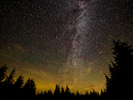- Messages
- 12,452

Astronomers are reporting that there’s a chance that a “meteor storm” could occur next Monday night. It probably won’t happen, but if it does, the display could be absolutely otherworldly.
The forthcoming Tau Herculid meteor shower ordinarily results in just a trickle of shooting stars between mid-May and mid-June, but there’s a chance it could be something extra special this year. Astronomers are focused on a clumping of cometary debris that — if positioned just right in Earth’s orbital track — could spark such an outburst of meteors.
Meteor showers happen when the Earth plows through a stream of debris left in the wake of comets, asteroids or other celestial bodies. Most are the size of grains of puffed rice or small pebbles, and produce blazing displays as they burn up in our outer atmosphere. Meteor storms result when Earth enters an unusually dense and intense clustering of interstellar debris — akin to driving through a swarm of bugs on the highway. In an instant, your windshield would be covered with smears streaking into your direction of travel.
That’s why — in the unlikely event that things line up just right — an outburst of up to 1,000 shooting stars per hour may be possible.
Where the debris is coming from
Every meteor shower is connected to an object in space. In the case of the Perseids in August, the debris comes from Comet Swift-Tuttle, while the Geminids in December are sparked by an asteroid called 3200 Phaethon. Both displays result in 50 to 100 meteors every hour when viewed beneath clear, dark skies.
With the Tau Herculid shower, the parent comet is Schwassmann-Wachmann 3 (SW3), which made its closest approach to the sun on Oct. 16, 2011. Since then, it’s been in the process of fragmenting and disintegrating.
The comet was discovered in 1930 and orbits the sun every 5.4 years. It wasn’t seen again, however, until late 1979, making a series of clandestine passes by Earth. The comet unexpectedly graced the night skies in 1995 after having apparently fractured into four pieces.
Now there are more than a dozen pieces, and each fragment, particularly that of 1995, can result in billions of tiny bits of debris.
Because of the effects of mass, gravity and pressure due to sunlight, some of the gravel-sized pieces of debris may take smaller orbits that would put them ahead of the main comet, and on a trajectory for possible intersection with Earth’s orbit.
Keep reading:
